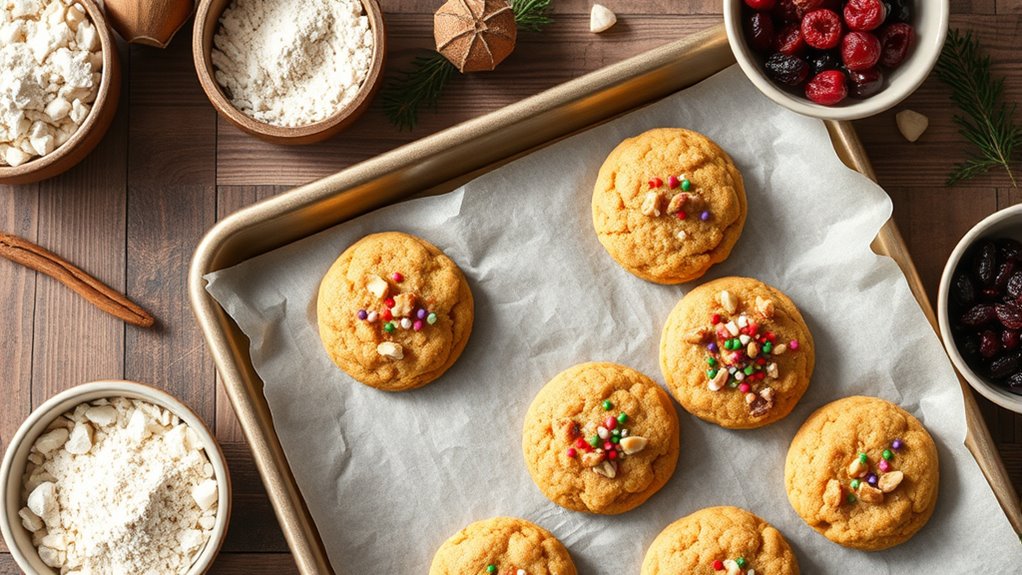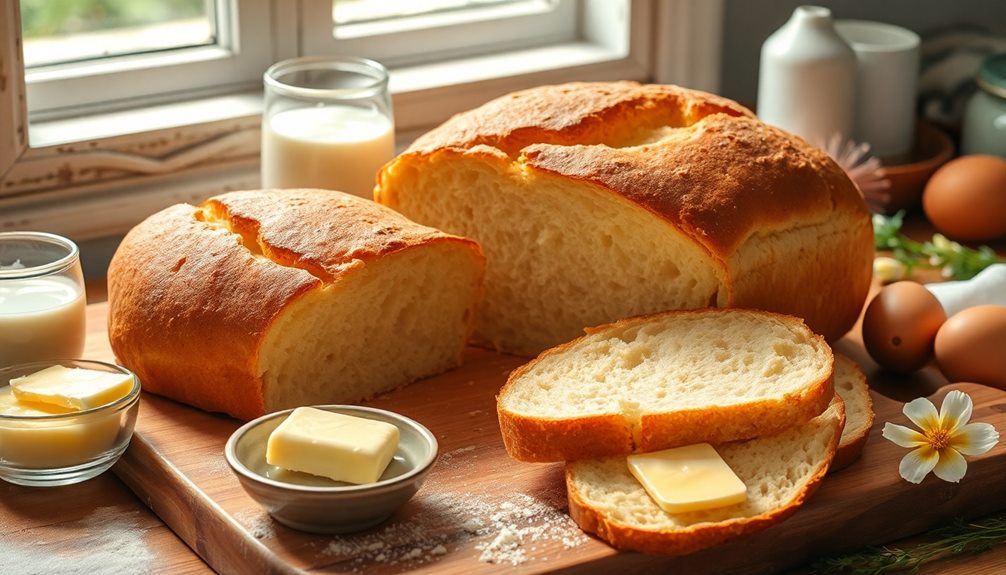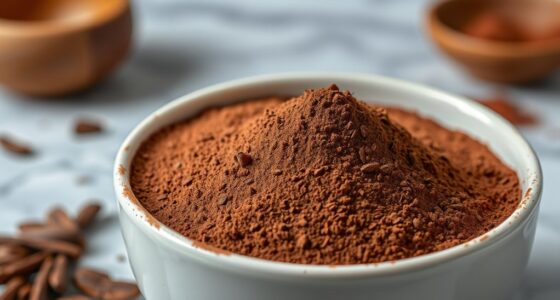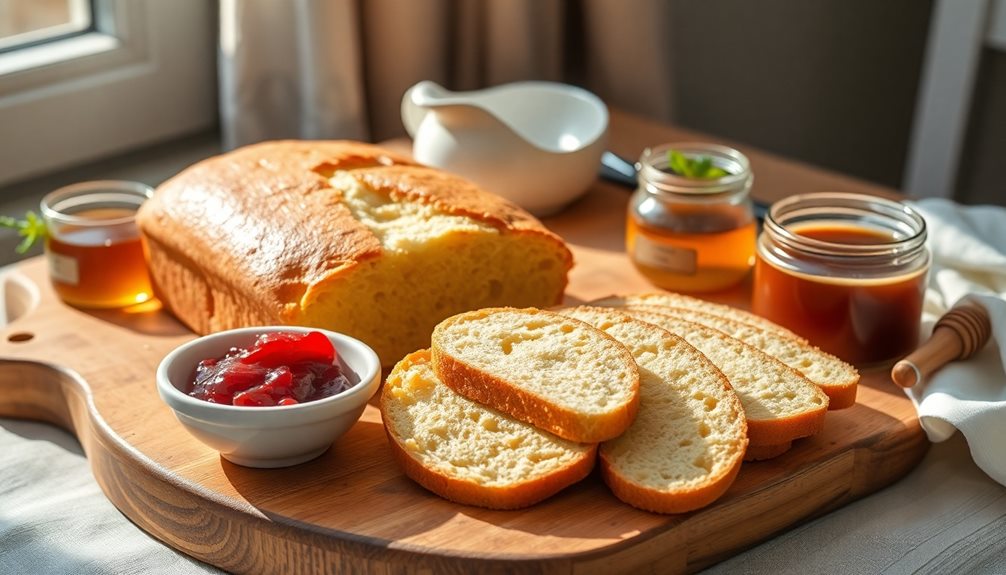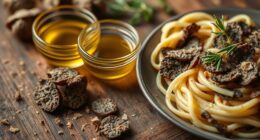To perfect your gluten-free holiday treats, choose a mix of flours like almond, rice, or tapioca to mimic gluten’s structure. Use natural sweeteners like honey or maple syrup to boost flavor and moisture. Incorporate binders such as xanthan or guar gum to give your baked goods the right texture. Adjust baking times carefully and stay patient—mastery comes with experimentations. Keep these tips in mind, and you’ll be crafting delicious treats that everyone will enjoy this holiday season.
Key Takeaways
- Use a blend of gluten-free flours like almond, rice, and tapioca for better texture and structure.
- Incorporate natural sweeteners such as honey or maple syrup to enhance flavor and moisture.
- Add xanthan or guar gum to bind ingredients and improve elasticity in baked goods.
- Adjust baking times and temperatures carefully, checking for doneness with a toothpick.
- Be patient and willing to experiment with different ingredients and techniques for perfect results.

Baking gluten-free can be challenging, but with the right tips, you can achieve delicious and satisfying results. One of the most important aspects is choosing the right gluten free flour options. Unlike traditional wheat flour, gluten-free flours such as almond, rice, tapioca, sorghum, and coconut flour each bring unique textures and flavors to your baked goods. Mixing different types can help mimic the structure and elasticity that gluten provides, so don’t hesitate to experiment with blends. For instance, combining rice flour with tapioca or potato starch can create a lighter, more tender crumb. Additionally, some specialty flour blends are available that already combine multiple gluten-free options, making your baking process easier.
Choosing the right gluten-free flours and blends is key to baking success.
When it comes to sweetening your treats, natural sweeteners are a fantastic choice. Not only do they add flavor without the processed sugars, but they also contribute to a healthier profile for your holiday treats. Use honey, maple syrup, agave nectar, or coconut sugar to sweeten baked goods naturally. These alternatives help keep your treats moist and tender, plus they often enhance the overall flavor profile. For example, maple syrup pairs beautifully with spices and nuts, while coconut sugar lends a caramel-like richness. When substituting natural sweeteners for refined sugar, remember that they may alter the moisture content and consistency of your batter or dough, so you might need to adjust other ingredients accordingly.
Another helpful tip is to incorporate binders like xanthan gum or guar gum, especially when working with gluten-free flours that lack elasticity. These ingredients help give structure to your baked goods, preventing them from crumbling or turning out dense. Be sure to add the right amount—usually around a teaspoon per cup of flour—so your treats hold together well without becoming overly chewy. Also, don’t forget to pay attention to your baking times and temperatures. Gluten-free baked goods often need slightly different settings to prevent over-baking or under-baking. Keep a close eye on them and use toothpicks or cake testers to check for doneness.
Finally, be patient and adaptable. Gluten-free baking can sometimes require a bit of trial and error, especially when aiming for holiday treats that look and taste festive. By selecting the right gluten free flour options, using natural sweeteners, and adjusting your techniques, you’ll be well on your way to creating memorable, delicious gluten-free holiday treats that everyone will enjoy.
Frequently Asked Questions
Can I Substitute Gluten-Free Flour for All-Purpose Flour Equally?
You can’t substitute gluten-free flour equally for all-purpose flour because it often requires adjustments for ideal gluten-free flavor and texture. Baking substitutions vary depending on the flour blend, so follow specific recipes or guidelines for gluten-free baking. You may need to add extra binding agents like xanthan gum or adjust liquids. Experimenting helps, but understanding these differences guarantees your treats turn out delicious and gluten-free friendly.
Are There Specific Binders Needed in Gluten-Free Baking?
Yes, you need binders in gluten-free baking to mimic gluten’s structure. Common binder alternatives include xanthan gum, guar gum, or chia seeds, which act as natural thickeners. You can also use psyllium husk or flaxseed meal for added binding. These natural thickeners help improve texture and elasticity, ensuring your baked goods hold together well. Adjust quantities based on your recipe to achieve the best results.
How Do I Prevent Desserts From Crumbling?
You might find it surprising, but ensuring your desserts don’t crumble starts with paying close attention to dough consistency and crumb structure. If your dough is too dry or crumbly, add a little moisture or binder to hold everything together. Similarly, for baked goods, avoid overmixing, which can lead to a fragile crumb. By balancing these elements, your treats will stay intact and delightfully tender, preventing unwanted crumbling.
What Are the Best Storage Methods for Gluten-Free Treats?
To keep your gluten-free treats fresh, store them in airtight containers to prevent moisture loss and staling. For longer storage, refrigerate them to maintain their texture and flavor, especially if they contain perishable ingredients like dairy or fruit. Make sure treats are completely cooled before sealing and refrigerating. This method helps preserve their taste and keeps them from becoming stale or soggy, ensuring they stay delicious for your holiday celebrations.
Can I Freeze Gluten-Free Baked Goods Successfully?
Yes, you can freeze gluten-free baked goods successfully. Use proper freezing techniques by wrapping treats tightly in plastic wrap or placing them in airtight storage containers to prevent freezer burn and maintain freshness. Label the containers with dates to track storage time. When you’re ready to enjoy, thaw them at room temperature or reheat in the oven. Proper freezing techniques and quality storage containers guarantee your baked goods stay delicious.
Conclusion
Now that you know the essential gluten-free baking tips, you’re ready to create holiday treats that everyone will love. Embrace the flexibility, trust your instincts, and don’t be afraid to experiment. Enjoy the process, savor the results, and share the joy. With these simple strategies, you’ll turn gluten-free baking into a festive celebration, making each bite memorable. So, get baking, stay confident, and let your holiday treats shine with flavor and flair.
